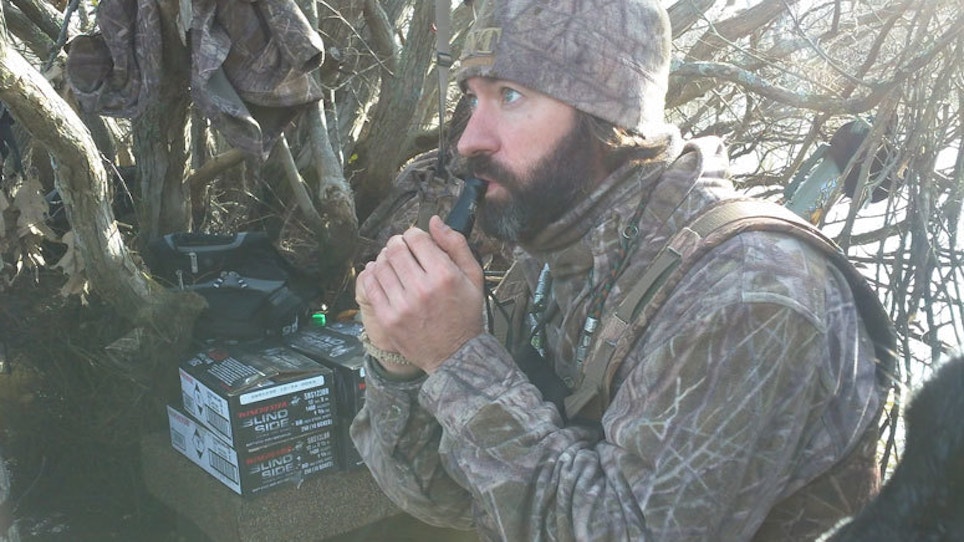In a duck-blind conversation with RNT Calls’ Jim Ronquest one day, we got to talking about high-tech duck hunting. Jim told me he holds nothing against hunters who use all the latest legal means to lure in ducks, but for him personally, it’s about perfection of skills.
I like that philosophy. Live decoys were outlawed in 1935. Today’s high-tech spreads essentially provide everything live decoys did short of calling and a well-trained Judas cajoling the flock to join the set in front of your blind. There’s an unmatched sense of accomplishment when success comes from your skills as a waterman, caller and hunter. And all old-school strategies have at their core watching and listening to unperturbed ducks.
Work The Water
Glass-flat water with motionless decoys makes pretty pictures, but it scares ducks. It only takes a few minutes observing flocked birds to realize there’s constant motion. Ducks move, so the water moves.
In timber hunting, birds flying above the canopy have a hard time seeing decoys. Their initial visual will be disturbed water. Widening concentric rings exponentially expand your spread’s power.
Any time you’re calling in the timber, and even when you’re not, you should be kicking a foot in the water. Move the water. This holds true in any setup without wind. On one slough hunt in Alberta, a hunting partner and I improvised by alternately shooting. The nonshooter was at the edge of the cattails bailing water into the pond to create motion. It worked so well, we both shot limits with neither of us picking up a call.
Work The Wind
Water and field spreads benefit from the appearance of flight and stretching wings. No other new-school innovation has boosted hunting success like the spinning-wing decoy. Old-school approximations are rags and wind socks. With breeze, both provide gentle, random, natural movement.
Maintain acute awareness of your decoy spread and blind position in relation to the wind. If the wind switches, even slightly, you need to reset and maybe even move. This might happen many times a day, but the results are worth the work.
Perfect Camouflage
Since you’re the source of motion and sound, it’s imperative to stay hidden. Motion dekes, splashers and spinners focus ducks’ attention on them. Without these distractions, ducks will focus on you! You won’t get away with corn camo in the timber, and dark patterns aren’t right in stubble fields. Consider a ghillie suit to add 3-D illusion. Gloves and headnets are musts.
In the timber, hug the shadows. As ducks circle, slowly move to keep the tree trunk between you and them, but once they break the canopy, stay still.
Superior Calling
Honest competition callers will admit, there’s a difference between calling in the blind and on stage. Competitive callers perfect routines incorporating skills judges expect to hear. Field calling responds to what the ducks are doing. Sometimes they want more; often they want less.
Calling depends on the type of hunting you’re doing. In the timber, calling loud, long, often and well is essential to attract the attention of ducks flying above the canopy. In other hunting, success depends far more on what the birds see.
Scout Locations
A lot of old-school duck tactics rely on “less is more,” but you can never have enough knowledge. If you know where birds want to be and get there before they do, you don’t need other tactics. Thinking like a duck is the consummate old-school skill, and the only way to acquire it is to do the homework. Twenty-first century scouting is easier with 4WD, optics, mobile phones, computers and satellite maps, but it remains an old-school strategy.
Finish The Ducks
New school, old school — the goal is to fool the birds so completely they don’t know you’re there. Whether you light them and jump to shoot, or take them at the last feet-down, wings-locked second, you should relish the accomplishment. But if you don’t wait, you can never achieve the goal.
Shooting working ducks at marginal ranges not only precludes you from this thrill, but it also makes it harder for every other hunter. Ducks become call-shy, decoy-shy and blind-shy because they are shot at and missed. Shooting only finished ducks results in fewer misses, meaning less shooting to take limits. That’s the finest old-school strategy going.






